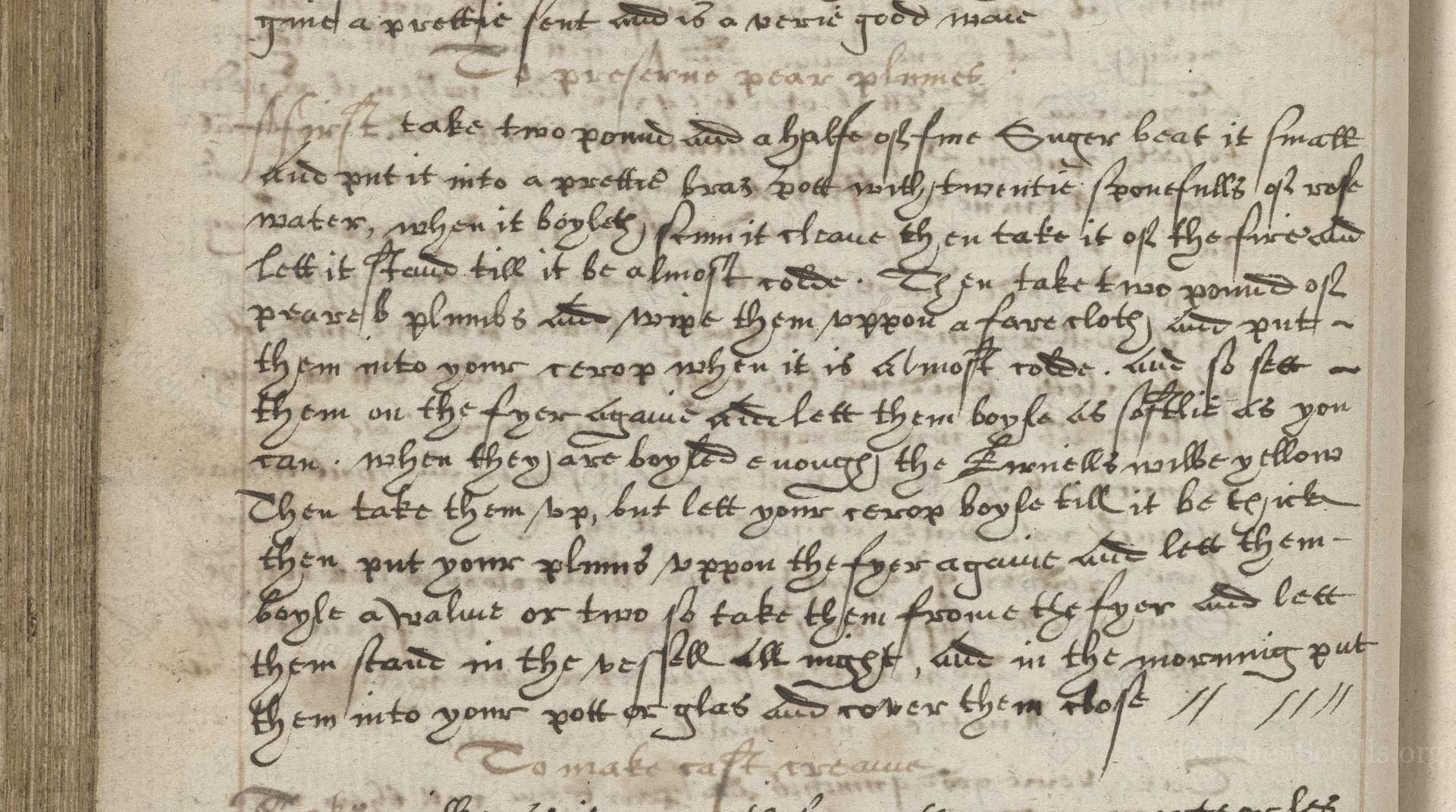To Preserue Pear Plumbs
From the treasured pages of Certain profitable and well experienced collections for making conserve of fruits
Written by Nicholas Webster

To Preserue Pear Plumbs
"Take a pound and a halfe of fine Suger beat it small and put it into a good brase pot with a quart of water, when it boyles skim it cleane then take two pounds of parsell plumbs take from them theyr stalks and put them into your syrop with it almost cold. then set them on the fyer & lett them boyle so fast as you can. when they are boyled enough the skinn will rise then take them up, but lett your syrop boyle till it be thick, then put your plumbs into the syrop againe and lett them take a walme or two so take them from the fyer and lett them stand in the syrop till all be cold in the morning put them into your pott of glase and couer them close // //"
Note on the Original Text
This recipe exemplifies early modern English culinary writing. Instructions are prose, given as a continuous narrative rather than step-by-step, reflecting the expectation that the cook had experience with these methods. Spelling is varied—‘preserue’ for preserve, ‘boyle’ for boil, ‘plumbs’ for plums—which was typical before standardised orthography. Measurements oscillate between weight and volume, demanding flexibility and knowledge from the reader. ‘Walme’ refers to a single bubbling up or simmer—so when the recipe says to let the plums 'take a walme or two,' it means to let them just come up to the boil once or twice in the thickened syrup.

Title
Certain profitable and well experienced collections for making conserve of fruits (1650)
You can also click the book image above to peruse the original tome
Writer
Nicholas Webster
Era
1650
Publisher
Unknown
Background
Step back to the bustling kitchens of mid-17th century England with this flavorful collection by Nicholas Webster. Savory secrets, age-old recipes, and period culinary wisdom await in this masterfully penned volume—a true feast for culinary history enthusiasts.
Kindly made available by
Folger Shakespeare Library
This recipe hails from England, circa 1650, and is attributed to Nicholas Webster. The mid-17th century was a time of blossoming domestic cookery, where preserving fruits in sugar was both a luxury and a necessity. Sugar, though expensive, was becoming more accessible for well-to-do households, allowing recipes like this to emerge in manuscript collections for the gentry. Preserving stone fruits such as plums provided a way to enjoy their fleeting sweetness long after the season had passed. Such recipes point to both the preservation techniques and the delicate dining preferences of the early modern English kitchen.

The original recipe would have used a ‘brase pot’, a heavy brass or copper cauldron, prized for its even heat. A wooden spoon for stirring, a ladle or slotted spoon for removing the fruit, and earthenware or glass jars for storage would round out the period kitchen. A low hearth or open fire would serve as the heat source, requiring careful attention to keep the syrup from scorching.
Prep Time
20 mins
Cook Time
40 mins
Servings
8
We've done our best to adapt this historical recipe for modern kitchens, but some details may still need refinement. We warmly welcome feedback from fellow cooks and culinary historians — your insights support the entire community!
Ingredients
- 1 1/2 pounds fine white sugar
- 4 1/4 cups water
- 2 pounds pear plums (or damson plums, greengages as substitutes if pear plums not available)
Instructions
- To make preserved pear plums with a touch of 17th-century flair, start by placing 1 1/2 pounds of fine white sugar and 4 1/4 cups of water in a sturdy saucepan.
- Bring this mixture gently to a boil, skimming any foam or impurities as they rise to ensure a clear syrup.
- Next, prepare 2 pounds of fresh damson or greengage plums (if pear plums are unavailable), removing their stems but leaving the skins intact.
- When your syrup is just about lukewarm, slip in the plums.
- Return the pan to the heat and let the fruit boil rapidly; when you notice the plum skins begining to split or lift, remove the plums from the syrup with a slotted spoon.
- Continue to boil the syrup until it thickens visibly—this shouldn’t be as dense as candy, but thicker than water, like a light honey.
- Return the plums to the thickened syrup and let them simmer genty for another minute or two.
- Remove from the heat and let the fruit cool, soaking in its syrup, overnight.
- The next morning, transfer both fruit and syrup into a sterilised glass jar and seal tightly.
- Your preserves are now ready for future enjoyment.
Estimated Calories
180 per serving
Cooking Estimates
Preparing the fruit and syrup takes around 20 minutes, including washing and destemming the plums. Cooking and boiling the syrup and plums takes about 40 minutes. You get about 8 servings, with each serving containing about 180 calories.
As noted above, we have made our best effort to translate and adapt this historical recipe for modern kitchens, taking into account ingredients nowadays, cooking techniques, measurements, and so on. However, historical recipes often contain assumptions that require interpretation.
We'd love for anyone to help improve these adaptations. Community contributions are highly welcome. If you have suggestions, corrections, or cooking tips based on your experience with this recipe, please share them below.
Join the Discussion
Rate This Recipe
Dietary Preference
Main Ingredients
Culinary Technique

Den Bockfisch In Einer Fleisch Suppen Zu Kochen
This recipe hails from a German manuscript cookbook compiled in 1696, a time whe...

Die Grieß Nudlen Zumachen
This recipe comes from a rather mysterious manuscript cookbook, penned anonymous...

Ein Boudain
This recipe comes from an anonymous German-language manuscript cookbook from 169...

Ein Gesaltzen Citroni
This recipe, dating from 1696, comes from an extensive anonymous German cookbook...
Browse our complete collection of time-honored recipes



